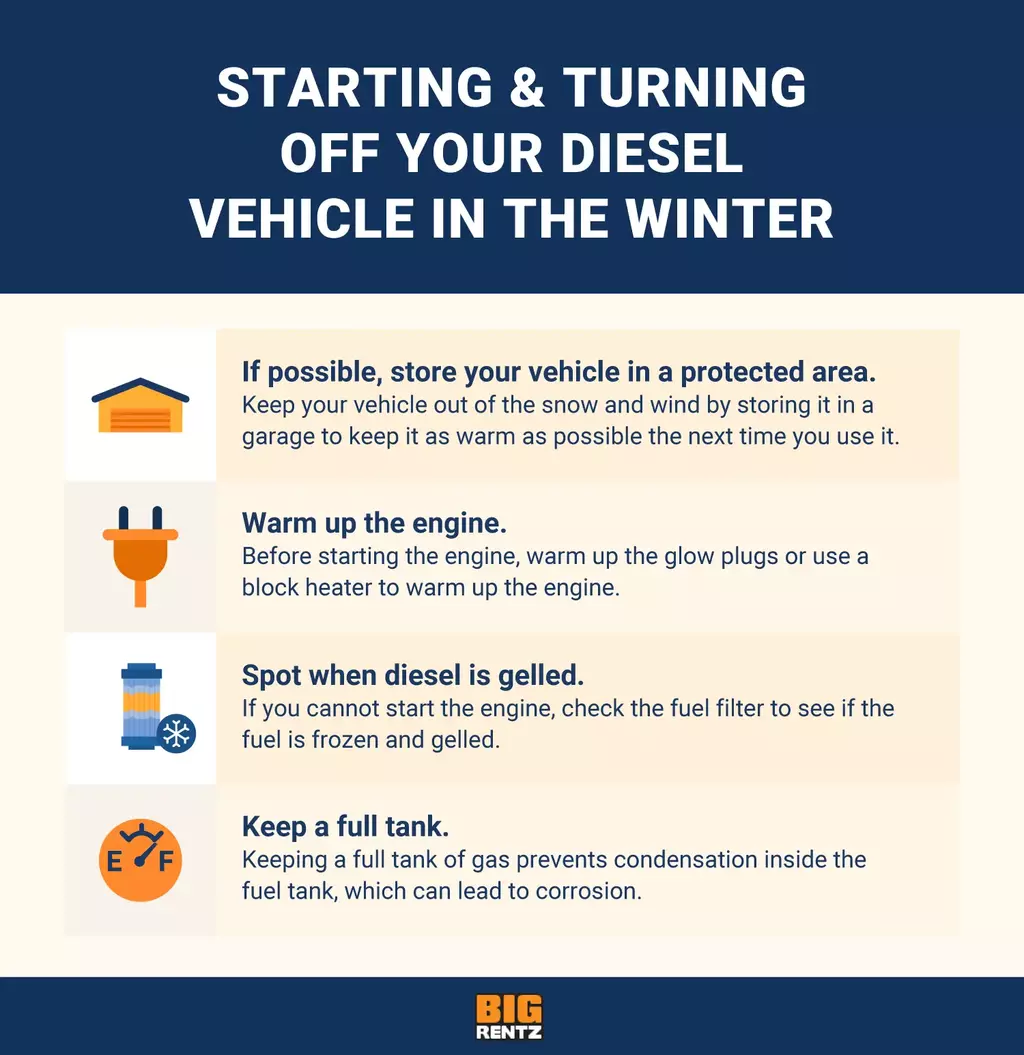If you drive a diesel vehicle, you might already be familiar with some of the problems you can run into with diesel fuel during the extremely low temperatures of the cold winter months. Cold temperatures from winter weather can cause fuel gelling, stalling, cold starts, and even drained batteries.
Your vehicle can have a difficult time starting if it isn’t prepared for cold weather because the fuel, battery, and other components depend on correct operating temperatures to function properly. Ignoring the weather can damage the vehicle, preventing it from running properly.
With cold weather just around the corner, you must prepare your diesel vehicle for safe driving during the winter months. This is especially true for diesel drivers, diesel truck drivers, or heavy equipment operators who operate diesel vehicles like snow removal loaders—not only do you need your vehicle to function to do your work, but your workplace, and the people you serve, depend on it, too.
In this article, we go over what issues diesel vehicles face in the cold winter months and how to prepare your diesel vehicle for the cold temperatures.
Issues Diesel Vehicles Face in Winter
Any vehicle battery uses more energy to run in cold weather, and diesel vehicles are no exception. Diesel vehicles are prone to several additional problems as well, including:
- Drained batteries
- Tire underinflation or damage
- Coolant expanding and damaging the engine
- Fuel freezing or gelling resulting in clogged fuel filters
- Poor starts due to thick engine oil or cold glow plugs
How to Prepare Your Diesel Vehicle for Winter Months
With all the possible issues cold weather can cause your vehicle, it’s important to prepare properly. Strategies like checking your battery, tires, and coolant before the winter even begins, using winter blended fuels to avoid fuel gelling, having a clean fuel filter, thinner engine oil, and warming up your engine before driving can help keep your diesel vehicle running safely all winter long.
The following sections give you the details on how to prepare your diesel vehicle for winter weather.
Check Your Battery
Diesel engines require more battery power to start and run in cold weather, so you can drain the battery quickly when you drive in the winter months. Checking your vehicle battery can help ensure it will run properly.
Start with the vehicle off. You can use a multimeter to check your battery health — just turn the meter on, and connect the leads to the battery. Check the voltage reading: 12.4 volts shows the battery is at 75% charge. You should probably charge the battery if it falls below that 75% mark.
Inflate Your Tires Properly
When the temperature is colder, tire inflation pressure decreases. You should monitor your tire pressure and ensure your tires are inflated properly according to the vehicle manual or heavy equipment operating manual. Check it before you use your diesel vehicle, especially if you’re operating heavy equipment.
Having over- or under-inflated tires can cause problems with your vehicle’s traction and braking capabilities, which can be dangerous.
Have the Appropriate Amount of Coolant in Your Vehicle
Having the right amount of coolant in your engine is very important in the winter months. Coolant expands when it freezes. Too much coolant can result in a cracked engine block, a problem that not only prevents your vehicle from running but that also makes it very expensive to repair.
Keep an eye on the coolant level in your vehicle. You can also get coolant that’s appropriate for winter months, or make a 50/50 water-to-coolant mix. If you’re unsure, always refer to the manual.
Use Winter Blended Diesel
Diesel fuel has a cetane number—cetane is a chemical property that allows diesel to ignite quickly. The cetane number refers to a diesel grade’s combustion speed and is related to the amount of paraffin wax in the fuel. The wax has no effect on your engine in warmer temps, but winter temps can be real game changers.
Fuel has a freezing point, known as a cloud point because as it freezes, fuel can take on a cloudy appearance. The cloud point of fuel in your vehicle depends on your fuel grade. If your vehicle is operating in freezing temperatures, your fuel can develop crystals from the paraffin wax, making it appear cloudy, and eventually turning into waxy buildup. This gelled fuel prevents fuel from getting to the engine and can clog your fuel filter, fuel lines, and fuel system.
Grade 1 diesel, also referred to as no. 1 diesel or winter diesel, works the best in cold weather because it has a lower wax content. You can also lower your cloud point by using a diesel fuel additive, such as anti-gels, or creating a winter blend diesel fuel, mixing 70% diesel no. 2 with 30% diesel no. 1 when the temperature begins to drop below 35 degrees Fahrenheit. Once the temperature drops into the negatives, you should switch to pure diesel no. 1.
Ensure the Fuel Filter Is Clean and Replace It if Needed
If the fuel freezes, the waxy buildup could clog the fuel filter, and your diesel vehicle likely will not run with a clogged fuel system. Ensuring that you’re using the correct fuel for cold temperatures, as well as cleaning your filter periodically, will help the fuel properly flow in your vehicle and keep your engine running.
If your filter is too dirty or clogged, you may need to replace it, so it doesn’t hurt to keep a spare fuel filter on hand.
Opt For a Thinner Engine Oil
Thinner engine oils have a much easier time helping your engine start because they have what’s known as a lower viscosity. It’s important to select an oil grade for the climate you’re in, or one that works through changing seasons, like a multi-weight oil.
Most engine oils are typed by one number, the straight weight, or two numbers, which is a multi-weight. The first number on a multi-weight oil is the viscosity grade of the oil. The lower this number is, the better it is in cold temperatures.
The second number is the viscosity grade of how the oil will flow when the engine is at normal operating temperature. The engine oil can still be appropriate for your vehicle even if this number is higher.
For example, an engine oil with the number 5W-30 (the “W” stands for winter) works better at lower temperatures than one numbered 15W-30. Keeping the right multi-weight oil grade in your vehicle at all times means you have the proper oil for the entire year, including the winter months. The manufacturer of your engine should have a recommendation for the safest engine oil number, so you don’t go too thin.
Warm Up the Engine Before Starting It
Warming up your engine before starting it and running it is another way to protect your vehicle in cold weather. Glow plugs can be a useful tool in warming your engine before you start it. They help heat the air and fuel mixture within the combustion chamber of the vehicle to ensure it starts properly.
Make sure you test your glow plugs before the winter season in case you need to replace them. They may not work well in helping the vehicle start if they are malfunctioning or cold.
To ensure the glow plugs get up to the right temperature to work properly, you should turn the key to the engine and let the start light shine on your dashboard for about 15 seconds. Once the start light goes out, you can turn on the engine. This signals that the glow plugs have had enough time to warm up.
Another way to warm up your engine is by using a block heater. Engine block heaters reduce the need for idling your vehicle. Many vehicles already come with block heaters installed, so make sure you test your block heater prior to the winter months to ensure it’s working well.
When winter weather hits, plug your block heater into an outlet for two to four hours, depending on how cold it is, to ensure your vehicle doesn’t cold start. It’s especially important to do this when at cold temperatures of 5 degrees Fahrenheit or lower.
Starting & Turning Off Your Diesel Vehicle in the Winter
Generally preparing your vehicle for winter weather should make it easier, safer, and better to operate. However, the most vulnerable times for your diesel vehicle are when you start and stop.
This list gives you things to keep in mind when starting and stopping your vehicle, including how to spot when diesel fuel gels, storing your vehicle properly, and warming up the engine as needed to prevent cold starts.
- If possible, store your vehicle in a protected area. Do your best to store and start your vehicle in an area out of the snow and wind to protect it and keep it warm in between uses, like an enclosed garage.
- Warm up the engine. Cold starts can not only prevent your engine from running, but they can also seriously damage your hardware. Warming your engine up to the proper temperature and using tools like glow plugs and block heaters ensures you can operate your vehicle safely.
- Spot when diesel is gelled. A telltale sign that your diesel fuel has gelled is when your vehicle can’t start—if your fuel is too crystallized, or the filter has too much buildup, it can’t flow through to the engine. Check the fuel filter to see if it has gelled, and replace the fuel or fuel filter as needed.
- Keep a full tank. Maintaining a full fuel tank helps avoid condensation, which can cause water droplets to mix with your diesel. When this water gets fed through your fuel injectors, your engine may sputter or shut off because your engine tries to spark combustion with water instead of diesel, leading to corrosion over time. Water can even damage your fuel system. Also, a full tank prepares you for unforeseen circumstances, like getting stuck in the snow or experiencing delays that require more fuel than you thought you would need.
Stay Safe During the Winter Months
During the harsh, cold weather of winter months, it’s as important to keep your vehicle safe and warm as it is for you to bundle up. Under the worst circumstances, heavy equipment unprepared for cold weather could cause it to break down.
While you hope it never happens, be prepared should your vehicle break down, get stuck, or stall, and you’re stranded in freezing temperatures for a few hours.
In a worst case scenario, here are some tips to stay safe:
- Stay with your vehicle. If your vehicle stalls or isn’t working, you should remain with the vehicle, ideally inside it, and not leave it to search for help. You risk getting lost and rapidly losing heat if you wander around in the cold weather.
- Don’t run your vehicle for long periods of time. While it may be tempting to keep the engine running for warmth, running a stalled vehicle with the windows up can cause a buildup of carbon monoxide, a poisonous gas.
- Place bright markers on or around your vehicle. Using bright markers will help your vehicle be more visible to passersby, letting them know you need assistance.













